
Lake Victoria is one of the African Great Lakes. With a surface area of approximately 59,947 km2 (23,146 sq mi), Lake Victoria is Africa's largest lake by area, the world's largest tropical lake, and the world's second-largest fresh water lake by surface area after Lake Superior in North America. In terms of volume, Lake Victoria is the world's ninth-largest continental lake, containing about 2,424 km3 (1.965×109 acre⋅ft) of water. Lake Victoria occupies a shallow depression in Africa. The lake has an average depth of 40 m (130 ft) and a maximum depth of 80–81 m (262–266 ft). Its catchment area covers 169,858 km2 (65,583 sq mi). The lake has a shoreline of 7,142 km (4,438 mi) when digitized at the 1:25,000 level, with islands constituting 3.7% of this length.

The Nile tilapia is a species of tilapia, a cichlid fish native to parts of Africa and the Levant, particularly Israel and Lebanon. Numerous introduced populations exist outside its natural range. It is also commercially known as mango fish, nilotica, or boulti.

Oreochromis is a large genus of oreochromine cichlids, fishes endemic to Africa and the Middle East. A few species from this genus have been introduced far outside their native range and are important in aquaculture. Many others have very small ranges; some are seriously threatened, and O. ismailiaensis and O. lidole possibly are extinct. Although Oreochromis primarily are freshwater fish of rivers, lakes and similar habitats, several species can also thrive in brackish waters and some even survive in hypersaline conditions with a salinity that far surpasses that of seawater. In addition to overfishing and habitat loss, some of the more localized species are threatened by the introduction of other, more widespread Oreochromis species into their ranges. This is because they—in addition to competing for the local resources—often are able to hybridize.

The Sevan trout is an endemic fish species of Lake Sevan in Armenia, known as ishkhan in Armenian. It is a salmonid fish related to the brown trout.

Ctenochromis pectoralis, the Pangani haplo, is a species of fish in the family Cichlidae. It was originally characterized in the Pangani River of Tanzania, and may also be present in Kenya. It is listed as extinct by IUCN as a result of a 1996 evaluation, but this appears to be incorrect. A more recent IUCN publication stated that this species is not endangered in any way.
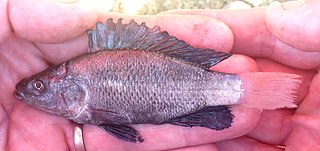
Oreochromis amphimelas is a species of tilapia cichlid endemic to north–central Tanzania, where it is found in Lake Manyara and a number of other saline lakes with closed basins. Maximum recorded size is 28 cm (11 in) in standard length.
Oreochromis chungruruensis, the Kiungululu tilapia, is a species of cichlid fish that is endemic to Lake Chungruru, a small isolated crater lake in the Rungwe District in southern Tanzania. This species reaches up to 15.4 cm (6.1 in) in standard length and 19.5 cm (7.7 in) in total length. It is critically endangered due to overfishing and non-native tilapia species that have been introduced to Lake Chungruru.

Oreochromis esculentus, the Singida tilapia or Graham's tilapia, is a species of cichlid endemic to the Lake Victoria basin, including some of its satellite lakes such as Kyoga, in Tanzania, Uganda, and Kenya. Its common name refers to Lake Singida, but this population is the result of an introduction that happened in the 1950s. This fish is highly valued by local fishermen, who know it as ngege.

The Lake Chala tilapia is a species of cichlid fish that is endemic to Lake Chala, a small crater lake on the border of Kenya and Rombo District of Kilimanjaro Region in Tanzania. It mostly lives in relatively deep water, at depths between 20–45 m (66–148 ft). It is considered critically endangered by the IUCN, with the two primary threats being deterioration of its habitat due to siltation, and other non-native tilapia species that have been introduced to Lake Chala. Before these introductions, the Lake Chala tilapia was the only fish in Lake Chala. It is very closely related to the similar Jipe tilapia, another highly threatened species from the same general region of Kenya and Tanzania. The Lake Chala tilapia can reach a standard length of up to 30 cm (12 in).
Oreochromis korogwe is a species of cichlid native to Kenya and Tanzania, where it occurs in the Pangani River system, as well as the Zigi River. This species can reach a standard length of 20.8 cm (8.2 in).
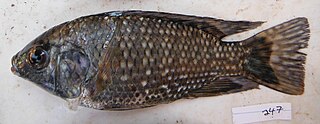
Oreochromis leucostictus is a species of cichlid native to Albertine Rift Valley lakes and associated rivers in DR Congo and Uganda. It has now been introduced widely elsewhere East Africa, and is believed to have negative ecological impact, particularly on native tilapias. This species is reported to reach a standard length of up to 36.3 cm (14.3 in), but is usually much smaller. It is exploited by small-scale fishery and aquaculture operations.
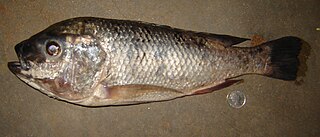
Oreochromis lidole is a species of freshwater fish in the family Cichlidae. This tilapia is native to Malawi, Mozambique and Tanzania, where it is found in Lake Malawi, Lake Malombe, the Shire River and perhaps some crater lakes further north. It is important in fisheries, but has drastically declined; it may already be extinct. This oreochromine cichlid is locally called chambo, a name also used for two other closely related species found in the same region, O. karongae and O. squamipinnis.

Oreochromis variabilis, the Victoria tilapia, is a species of African cichlid native to Lake Victoria and its tributaries, Lake Kyoga, Lake Kwania, and Lake Bisina (Salisbury), as well as being found in the Victoria Nile above Murchison Falls. This species can reach a standard length of 30 cm (12 in). This species is important to local commercial fisheries and is potentially important in aquaculture. It is also found in the aquarium trade.
The Pangani robber is a species of fish in the family Alestidae. It is found in the Pangani River drainages, including Lake Jipe, in Tanzania and Kenya. Its natural habitats are rivers and lagoons.

Lake Chala, also known as Lake Challa, is a crater lake that straddles the border between Kenya and Tanzania. The lake formed approximately 250,000 years ago. The lake is east of Mount Kilimanjaro, 8 kilometres (5.0 mi) north of Taveta, Kenya, and 55 kilometres (34 mi) east of Rombo District. The lake is surrounded by a steep crater rim with a maximum height of 170 metres (560 ft).

Lake Jipe is an inter-territorial lake straddling the borders of Kenya and Tanzania. On the Kenyan side, it is located south of the village of Nghonji while on the Tanzanian side, it is situated within Mwanga District, in Kilimanjaro Region. The lake is fed mainly by the Lumi River, which descends from Mount Kilimanjaro, as well as streams from the North Pare Mountains, being on the leeward side. The lake's outlet forms the Ruvu River. Kenya's unfenced Tsavo West National Park protects part of the lake's northern shore, while on the Tanzania side Mkomazi Game Reserve is nearby. The lake is known for its endemic fish, as well as water birds, mammals, wetland plants and lake-edge swamps, which can extend 2 kilometres (1.2 mi) from Jipe's shore.
The River Lumi is located in Rombo District, Kilimanjaro in northereast Tanzania and a small part in southern Kenya in Coast Province. It originates on the east side of Mawenzi peak on the east side of, and flows so close to the River Rombo as almost to form a fork. The Lumi, however, maintains its southerly direction, and may thus be said to represent the upper course of the Ruvu, one of tho two main sources of the Pangani River. It flows around the Lake Chala and the Taveta town in the west and empties into the Lake Jipe. The fish species Barbus sp. 'Pangani' has only been found in the river's N'joro Springs, situated in the upper Pangani River drainage basin.
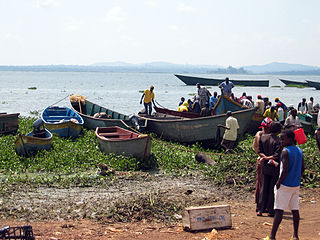
Lake Victoria supports Africa's largest inland fishery, with the majority of the catch being the invasive Nile perch, introduced in the Lake in the 1950s.
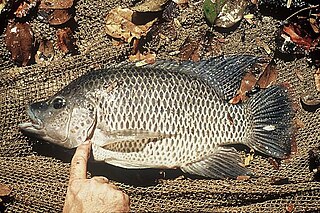
Oreochromis mortimeri, the Kariba tilapia or kurper bream, is a species of cichlid, formerly classified as a Tilapiine cichlid but now placed in the genus Oreochromis, the type genus of the tribe Oreochromini of the subfamily Pseudocrenilabrinae. It is found in the rivers of south central Africa especially the middle Zambezi where it is endangered by the spread of invasive congener Oreochromis niloticus.

Lake Victoria supports Africa's largest inland fishery, with the majority of present catch being the invasive Nile perch, introduced to the Lake in the 1950s. Prior to the introduction of Nile perch as well as Nile tilapia, the fish community was very different and consisted mainly of 'Ngege' and Victoria tilapia as well as vast numbers of Haplochromis species. Fish communities in the first half of the 20th century are known primarily from a unique fisheries survey conducted in 1927-1928 by the Colonial Office.

















